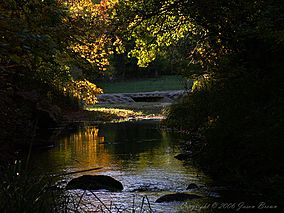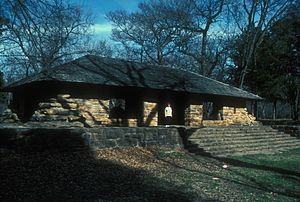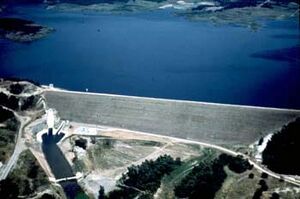Chickasaw National Recreation Area facts for kids
Quick facts for kids Chickasaw National Recreation Area |
|
|---|---|

Travertine Creek, in the Chickasaw National Recreation Area
|
|

Map of the Chickasaw National Recreation Area
|
|
| Location | Murray County, Oklahoma, USA |
| Nearest city | Sulphur, OK |
| Area | 9,899 acres (40.06 km2) |
| Established | July 1, 1902 |
| Visitors | 1,212,139 (in 2011) |
| Governing body | National Park Service |
| Website | Chickasaw National Recreation Area |
The Chickasaw National Recreation Area is a special outdoor place in south-central Oklahoma. It's located near the town of Sulphur in the foothills of the Arbuckle Mountains. This area combines what used to be Platt National Park and the Arbuckle Recreation Area.
The park was first created on July 1, 1902, as the Sulphur Springs Reservation. It was later renamed Platt National Park in 1906. On March 17, 1976, Platt National Park joined with the Arbuckle Recreation Area. Together, they became the Chickasaw National Recreation Area.
This park helps protect the beautiful hills of south-central Oklahoma. It's named to honor the Chickasaw Indian Nation. The Chickasaw people were moved to this area in the 1830s. They later sold the original land for the park to the U.S. government.
The park's springs, streams, and lakes offer many fun activities. You can go swimming, boating, fishing, picnicking, camping, and hiking. The Chickasaw tribe made an agreement with the U.S. government. Because of this, there is no admission fee to enter the park.
Contents
A Look Back: How This Park Began
When the Choctaw and Chickasaw tribes moved to this area, they found many natural springs. These springs had both fresh water and mineral water. The tribes believed these waters had healing powers.
They worried that private companies would buy the springs. This had happened before at Hot Springs, Arkansas. So, the Chickasaw tribe sold 640 acres of land to the U.S. Government. This happened in 1902. The area was then named the Sulphur Springs Reservation.
Platt National Park: A Small but Popular Spot
In 1902, Orville H. Platt, a U.S. Senator, helped create the Sulphur Springs Reservation. This protected 32 freshwater and mineral springs. The reservation officially opened to the public on April 29, 1904.
On June 29, 1906, the reservation was renamed Platt National Park. It was named after Senator Platt, who had passed away. It was the seventh and smallest national park in the United States. It was also the only national park in Oklahoma at that time.
Many visitors came to the new national park. Train lines were built to Sulphur, making it easy to reach the park. In 1914, Platt National Park had more visitors than famous parks like Yellowstone or Yosemite.
In the 1930s, workers from the Civilian Conservation Corps (CCC) helped build up the park. They created pavilions, buildings, and enclosures for the springs. Their work made the park a peaceful and beautiful place. This historic area was recognized as a National Historic Landmark in 2011.
Becoming the Chickasaw National Recreation Area
Platt National Park was changed by Congress in 1976. It became part of the much larger Chickasaw National Recreation Area (CNRA). This new area also included the Lake of the Arbuckles.
In 2011, the United States Mint released a special quarter coin. It featured the Chickasaw's Lincoln Bridge. This limestone bridge was built in 1909 to celebrate the 100th birthday of Abraham Lincoln.
Exploring the Travertine District
The Travertine district is like a large city park. It's about three miles long and less than one mile wide. A small road goes around the district. It passes by parking areas, camp and picnic spots, and the Travertine Nature Center. You can also find swimming holes, springs, and a bison pasture here.
Travertine Creek flows through this district. It starts from Antelope Springs and Buffalo Springs. These springs produce about 5 million gallons of cool, clear water every day. Travertine Creek is joined by Rock Creek. Many other springs also add water to these creeks. They flow over small ledges, creating little waterfalls.
There are several miles of walking and biking trails. These trails wind through the thick forests along the creek. The Travertine district is very popular and can get crowded in summer. It's often called an oasis in the Oklahoma prairie.
Fun at Lake of the Arbuckles
Most of the National Recreation Area is covered by the 2,350-acre Lake of the Arbuckles. This includes the lake itself and the land along its shores. This scenic lake is a main water source for the city of Ardmore.
Lake of the Arbuckles was built in 1966 by damming Rock Creek. The water quality here is excellent. The Oklahoma Department of Wildlife Conservation says it's the best lake in the state for bass fishing. The lake has 36 miles of shoreline.
You can fish all year for different types of fish. These include crappie, catfish, largemouth bass, and bluegill. The lake has three campgrounds for tents and RVs. There are also picnic areas, restrooms, boat docks, and ramps. Several miles of trails are available for many uses.
Hunting is also allowed in some areas. People typically hunt quail, turkey, squirrel, rabbit, dove, ducks, geese, and deer. However, because many people hunt here, the number of animals is going down. Special rules are in place to help manage the hunt.
Images for kids






